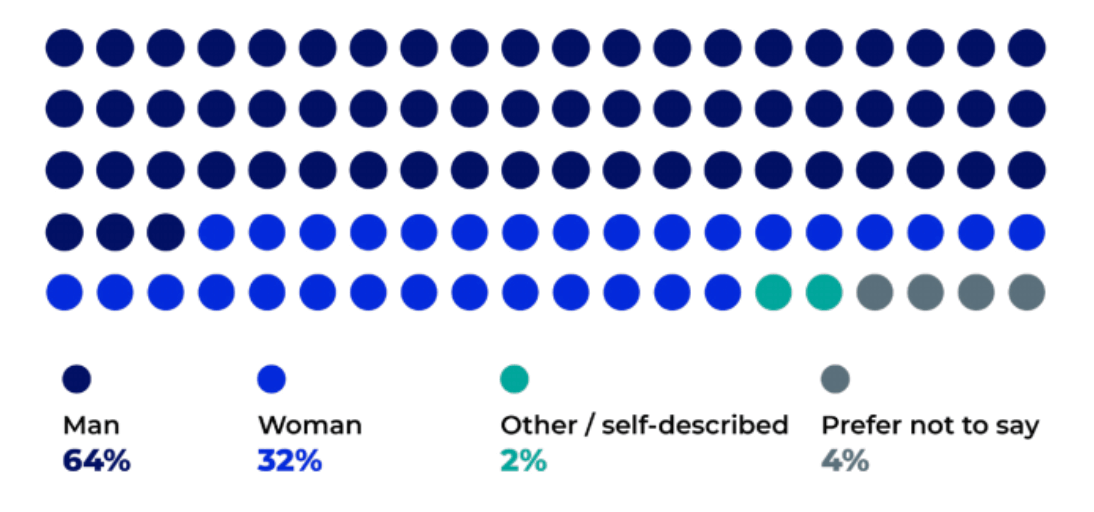Amazon is an equal-opportunity e-commerce platform. Yet, in 2021, more than two-thirds of its third-party sellers are men. The proportion of sellers who identify as women is now slightly higher than 2020’s 26% figure, but still marks an interesting gap in gender representation on Amazon.
That got us thinking—what other variances exist between the genders with regard to selling on Amazon?
We surveyed thousands of Amazon sellers to identify those differences.
Here are a few key discoveries:
- Men tend to sell on Amazon at a younger age than women
- Women spend less time and money than men launching their Amazon businesses
- Men are more likely to view their Amazon business as a hobby
- Women follow Amazon’s rules and guidelines more closely
- Women and men are optimistic about the future of selling on Amazon, but more men than women would recommend selling to others
We also gained insights into the following:
- How sellers invest time and money into their Amazon businesses
- Their experience with Amazon and e-commerce
- Their preferred selling methods and product categories
- What they think of Amazon
Note: For a complete picture of the profile of an Amazon seller, check out our report on Amazon seller demographics in 2021.
Only 32% of Amazon’s sellers are women
Despite the fact that selling on Amazon is open to anyone, regardless of gender, the seller community is primarily made up of men.

Nearly two-thirds of Amazon sellers (64%) identify as ‘Male’. On the other hand, just over one third (32%) identify as ‘Female’, while 6% of sellers identify as ‘Other’.
Men start selling on Amazon younger
Though there are men and women of all ages currently selling on Amazon, there are distinct differences in behaviors between these two genders across age groups.
- Men tend to start their Amazon businesses at a younger age than women, with 19% of men launching on Amazon between ages 18 and 35. On the other hand, only 13% of women began selling in that age range
- Men also have greater representation among sellers aged 35 to 54: this age group is 33% male and only 18% female
- By their late 50s and 60s, the number of women and men first starting out on Amazon evens out. 10% of women and 9% of men say they started selling on Amazon between the ages of 55 and 64
Women spend less time and money launching their Amazon businesses
From finding a product to launching their first active listing on Amazon, women spend less time getting their Amazon businesses up and running than men do. They also spend less time maintaining their listings each week once they’re live, and are more likely than men to work only on their Amazon businesses.
Time investments in Amazon and other employment
- Women get their Amazon businesses up and running faster: within six weeks of launching, 41% of women had listed their first product, versus 33% of men
- Women also turn a profit sooner: 26% became profitable after just 3 months, versus 18% of men
- 60% of women were successful in their first product launch, versus 52% of men
- Women spend less time each week managing their Amazon businesses: 16% of women and 12% of men spend fewer than four hours per week, while 22% of women and 25% of men spend over 30 hours a week
- More men than women work full-time jobs outside of the home in addition to selling on Amazon (41% of men versus 27% of women)
- A quarter of female Amazon sellers work exclusively on their Amazon businesses, versus 22% of male sellers. Furthermore, 27% of women surveyed say they’re self-employed outside of Amazon, versus 22% of men
Financial investments
Women tend to spend less to start their Amazon businesses.
- 34% of women spent less than $1,000 to get up and running on Amazon, versus 25% of men
- 36% of men spent more than $5,000 to launch their Amazon business, versus 31% of women
Monthly and lifetime sales
- Over a quarter of both men and women report average monthly sales of over $25,000
- However, slightly more women than men report monthly sales below $1,000 (29% of women versus 26% of men)
Curiously, women are slightly stronger than men in terms of total lifetime sales. This could be explained by the fact that there are more women than men who have been selling on Amazon for over three years (56% of women versus 51% of men).
Profitability
- Women report slightly higher profit margins than men: 35% of women achieve profit margins between 21-50%, versus 30% of men
- While there relatively few sellers with $1 million or more in lifetime profits, more women achieve this (8% of female sellers) than men (5% of male sellers)
Men are more likely to view their Amazon business as a hobby
An Amazon business represents many sellers’ first foray into online entrepreneurship, though women tend to take selling more seriously.
- 60% of men and 56% of women said selling on Amazon is their first experience as a web entrepreneur
- 8% of women consider selling on Amazon to be a hobby, as opposed to 10% of men
- Women are more likely than men to say they started selling on Amazon out of a desire to earn more income, feel successful, tackle a challenge, and gain the flexibility to travel or work remotely
Men prefer selling private label products on Amazon
Selling private label items on Amazon requires a bigger investment up front, particularly when compared to retail and online arbitrage.
For that reason, and the fact that 23% of women reported started their Amazon businesses with less than $500, the following statistics are unsurprising:
- 75% of men and 56% of women sell private label products
- Women use the online and retail arbitrage (OA and RA) business models more than men do: 46% of women versus 35% of men
Women follow Amazon’s rules and guidelines more than men
Though the Amazon marketplace is extremely competitive for sellers, only 6% of women have engaged in sales-boosting strategies that violate Amazon’s Terms of Service, otherwise known as black hat tactics. 12% of men, on the other hand, have used black hat tactics to get ahead.
Women and men sell in varying categories
Categories with significantly higher numbers of male sellers than female sellers include Electronics, Automotive Parts, and Tools & Home Improvement.
Here are the categories showing the highest differential between women and men:
- Electronics: 17% of men and 10% of women sell in this category
- Automotive Parts: 10% of men, 6% of women
- Grocery & Gourmet Food: 11% of men, 20% of women
- Health, Household & Baby Care: 18% of men, 27% of women
Women: Top 5 categories
- 47% – Home & Kitchen
- 25% – Toy & Games
- 27% – Health, Household & Baby Care
- 25% – Sports & Outdoors
- 24% – Kitchen & Dining
Men: Top 5 categories
- 44% – Home & Kitchen
- 24% – Sports & Outdoors
- 23% – Toys & Games
- 20% – Beauty & Personal Care
- 19% – Tools & Home Improvement
Men and Women are optimistic about the future of selling on Amazon
Men and women generally view Amazon positively. Both groups think Amazon is a good company for e-commerce sellers, now and looking forward to the years ahead.
- 50% of both women and men think Amazon is a good company for sellers
- 69% of women and 66% of men are optimistic that selling on Amazon will be a viable way to make money online in the future
- 61% of male sellers would recommend selling on Amazon to others. 55% of female sellers would do the same
- 74% of male sellers and 63% of female sellers wish they had started selling on Amazon sooner
Methodology
The data above report references answers from 989 respondents who have more than one year of experience selling on Amazon, and have at least one active listing. Respondents sell in all 17 global Amazon marketplaces, in all relevant Amazon product categories, and range in age from 18 to 80+.
For more insights on how Amazon sellers run their businesses, check out the 2021 State of the Amazon Seller Report.

 No Comments
No Comments